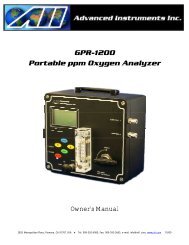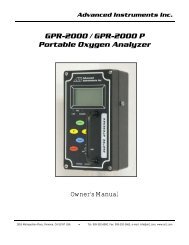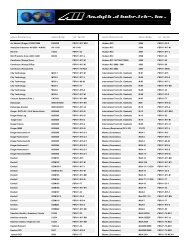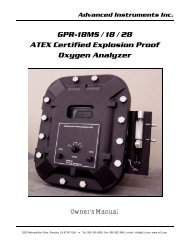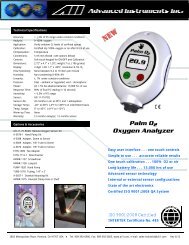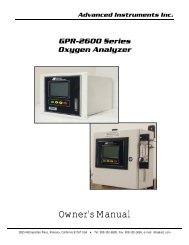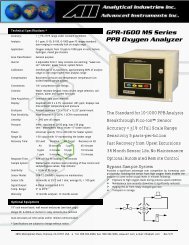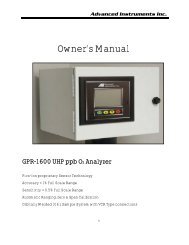GPR-1800 AIS ATEX Trace PPM Oxygen Analyzer - Advanced ...
GPR-1800 AIS ATEX Trace PPM Oxygen Analyzer - Advanced ...
GPR-1800 AIS ATEX Trace PPM Oxygen Analyzer - Advanced ...
- No tags were found...
Create successful ePaper yourself
Turn your PDF publications into a flip-book with our unique Google optimized e-Paper software.
<strong>Advanced</strong> Instruments Inc.Spill or LeakSteps if material is releasedDisposalSensor is packaged in a sealed plastic bag, check the sensor inside for electrolyte leakage. If thesensor leaks inside the plastic bag or inside an analyzer sensor housing do not remove it withoutrubber or latex gloves and safety glasses and a source of water. Flush or wipe all surfacesrepeatedly with water or wet paper towel (fresh each time).In accordance with federal, state and local regulations.Health Hazard InformationPrimary Route(s) of EntryIngestion, eye and skin contactExposure Limits Potassium Hydroxide - ACGIH TLV 2 mg/cubic meter or Acetic Acid - ACGIH TLV / OSHA PEL 10ppm (TWA), Lead - OSHA PEL .05 mg/cubic meterIngestionElectrolyte could be harmful or fatal if swallowed. KOH = Oral LD50 (RAT) = 2433 mg/kg or AceticAcid = Oral LD50 (RAT) = 6620 mg/kgEyeElectrolyte is corrosive and eye contact could result in permanent loss of vision.SkinElectrolyte is corrosive and skin contact could result in a chemical burn.InhalationLiquid inhalation is unlikely.SymptomsEye contact - burning sensation. Skin contact - soapy slick feeling.Medical Conditions AggravatedNoneCarcinogenic Reference DataKOH and Acetic Acid = NTP Annual Report on Carcinogens - not listed; LARC Monographs - notlisted; OSHA - not listedOtherLead is listed as a chemical known to the State of California to cause birth defects or otherreproductive harm.Special Protection InformationVentilation RequirementsEyeHandRespirator TypeOther Special ProtectionSpecial PrecautionsPrecautionsTransportationNoneSafety glassesRubber or latex glovesNot applicableNoneDo not remove the sensor’s protective Teflon and PCB coverings. Do not probe the sensor withsharp objects. Wash hands thoroughly after handling. Avoid contact with eyes, skin and clothing.Empty sensor body may contain hazardous residue.Not applicable37



